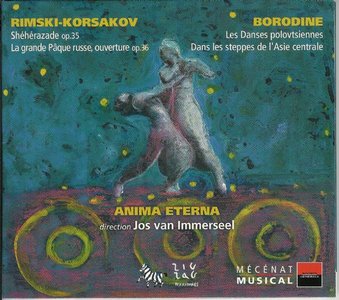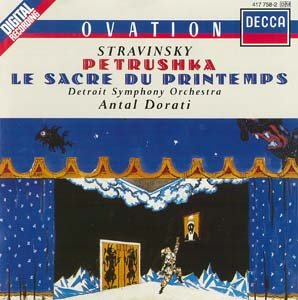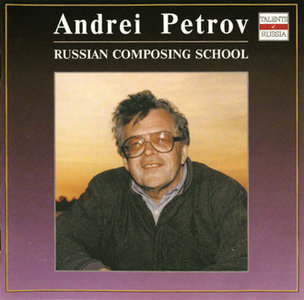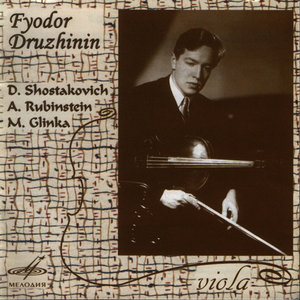Translate a Web Page
Ôîðóì
Ïîìîùü
ñàéòó
Ãîñòåâàÿ êíèãà
-
Rimsky-Korsakov, Borodine ~ Immerseel &
Anima Eterna
-
Igor Stravinsky : Petrushka, The Rite of Spring
- Antal Dorati
-
Andrei Petrov: Russia of Bells/Y.
Temirkanov (1995)
-
Fyodor Druzhinin - Russian
Viola Sonatas (2004)
Rimsky-Korsakov, Borodine
~ Immerseel & Anima Eterna
 Classical
| Eac, Ape+cue, log | covers+booklet | 1 Cd, 329 Mb | 70'37"
Classical
| Eac, Ape+cue, log | covers+booklet | 1 Cd, 329 Mb | 70'37"
26 mai 2005 | Zig Zag Territoires | Filesonic + Fileserve
"The immediate impression here is of a solidly based orchestral sound--not
surprising, as the band balances 12 violins and four violas with three
cellos and three double basses." -- BBC Music magazine
I was unprepared for the incredible richness these performances offer. Here
were colors and harmonies that I simply did not remember hearing in these
works before...For anyone else who wants to hear this familiar repertoire in
an exciting new way, I cannot recommend this release highly enough. --
FANFARE: Ronald E. Grames
I wouldn’t have thought the world was anxiously waiting for a historically
informed performance of Rimsky-Korsakov’s Scheherazade. Written in 1888 and
a masterpiece of orchestration, it would seem that this was one work that
really cries out for the full resources of a modern symphony orchestra. So I
was surprised when I saw a listing for this new recording with the
Bruges-based period-instrument ensemble, Anima Eterna. Despite all the heat
generated in some quarters, I remain fairly neutral regarding H.I.P., seeing
it neither as the salvation of music from 20th-century excesses nor as the
death of music through formalism. At their best, H.I.P. performances throw a
different light on the overly familiar. I—and I know many others—hear
Beethoven, Bruckner, even Strauss, Elgar and Tchaikovsky a bit differently
through the good offices of Zinman, Herreweghe, Harnoncourt, Norrington, and
others. But, Scheherazade? I decided to throw aside preconceptions. I am
glad I did, for the experience was truly ear opening.
I thought I knew the works on this disc. These pieces, after all, almost
define the term “war-horse.” I was unprepared for the incredible richness
these performances offer. Here were colors and harmonies that I simply did
not remember hearing in these works before. The experience sent me back to
my stacks for a refresher. I listened to a variety of recordings, dating
from the 1927 Stokowski to the 2002 Gergiev. What I heard validated Jos van
Immerseel’s statement that “frequently performed pieces are often subject to
wear.” There were fine performances ranging from the sensuous (Stokowski,
Serebrier) to the dramatic (Reiner, Kondrashin) to the charming (Beecham,
Matacic). All of these, however, emphasized the strings to the detriment of
the woodwinds, and sometimes even the brass, in a way I had not noticed
before. Where I had expected the modern orchestras to provide the greater
resources of color, the opposite turned out to be the case. Only three
recordings—the Dorati/Minneapolis Symphony on Mercury 462953 (available on
an arkivmusic.com CD reissue), the Matacic/Philharmonia on EMI (currently on
Testament 1329), and the Karajan/Berlin Philharmonic on Deutsche Grammophon
(Originals 463614)—came close to offering the wind detail and exquisite
balance between sections and choirs offered by the Anima Eterna orchestra.
None of these would be among my first choices, though I like the first two
very much. The Dorati, admittedly with a smaller than typical string section,
achieves its magic through a very dry acoustic; the Matacic, through careful
balancing and lower dynamic levels during much of the work; the Karajan,
through super-human wind-playing and (I suspect) some brute-force technical
manipulation.
None of this is needed by Immerseel and his band. The comparatively small
string section (8-8-6-6-5) balances well with the wind choirs at every
dynamic level. Minimal vibrato, while it sounds a bit stark to 21st-century
ears, creates great transparency. The smaller-bore low brass have great
presence, even when playing softly, and snarl marvelously when played forte.
French horns are clearly audible without having to blast over a huge string
section. As a bassoonist, I was particularly pleased to hear the second
bassoon parts balanced with the double basses and trombones. Intonation
throughout is exceptional and precision is often amazing.
None of this would matter, of course, if the performances were second-rate.
This performance of Scheherazade deserves to be considered in the same
company as any of my previous favorites: early Stokowski (Biddulph 10-OP,
Cala 521), Beecham (EMI 66998), Reiner (RCA 66377 SACD), Kondrashin (Philips
Originals 000708802), Haitink (Philips 420898, out of print, but worth
looking for), and Serebrier (Reference 89). Unlike Gergiev in the recent
Kirov recording on Philips 470840, the dynamics are observed and climaxes
are effectively built. Unlike the generally fine Spano on Telarc 80568,
tension does not wane. Though intrinsically smaller scaled than competing
recordings, which use orchestras much larger than the 59 players employed
here, there is no lack of power at the climaxes. In fact, the lower brass
and percussion here are more impressive than on most recordings. And the
thrill of hearing all that newly revealed color and detail at all dynamic
levels cannot be gainsaid. As compensation for the scale, there is a sense
of intimacy in this performance that I have found only in the Beecham and
Matacic. This is especially evident in the wonderfully poised third movement,
which is characterized by some of the most beautiful string tone I have ever
heard. Among the highlights of the performance are the violin solos,
performed by concertmaster Midori Seiler. She uses vibrato sparingly and
expressively. If she is not quite the equal of Krebbers, Friend, or Hilsberg
in terms of interpretive imagination, she does not at all embarrass herself
in this company.
The performance of the Russian Easter Festival Overture, based on Russian
liturgical chants and composed in the same year as Scheherazade, is equally
fine and just as much of a surprise. The use of smaller-bore trombones is
especially telling in this piece, where they have so prominent a part.
Modern instruments can sound bland at lower dynamics, but that is certainly
not a problem here. The trombone solos are especially well taken by tenor
trombonist Cas Gevers. However, it is the woodwinds, again, that really
distinguish this recording. The distinctive coloration of period instruments
give an exotic quality to the wind choruses that suggests the sound of
Orthodox liturgical chant in a way I’d never noticed before, despite the
origins of this work.
A couple of quibbles must be noted here: there was a bit of uncharacteristic
scrappiness in the playing of the violins in this work and the trumpets
really were not sufficiently powerful to cap a couple of chords effectively.
These are very small issues, but deserve mention, given the prevailing high
standards.
The Borodin selections sound less startling, though they, too, are very well
performed. The high unison violin part at the beginning of In the Steppes of
Central Asia, composed for the 25th anniversary of Czar Alexander II’s
ascension to the Russian throne, is usually played with little or no vibrato,
so this will sound familiar. The proudly marcato approach taken elsewhere by
Immerseel is just right for this attractive piece of imperial propaganda.
The “Polovtsian Dances,” from the opera Prince Igor, are very familiar to
most listeners. Because they depend heavily on wind-writing, with little
sustained string-writing, the contrast with modern-instrument performances
is less than in the other works on this disc. Bass trombonists and
percussionists will love the fourth dance.
There are informative notes regarding all of the works in French, English,
and German, as well as comments on performance practice by the conductor.
The sound quality is excellent and the presentation attractive. For those
allergic to H.I.P. who don’t have a recording of Scheherazade (hard as that
is to imagine), any of the favorites listed above should serve. One can
almost choose on the basis of need for modern sound and find a happy match.
For anyone else who wants to hear this familiar repertoire in an exciting
new way, I cannot recommend this release highly enough. -- FANFARE: Ronald
E. Grames
Que ce soit dans les œuvres classiques ou dans le répertoire russe de la fin
du XIXe siècle, la démarche de Jos van Immerseel vise aux mêmes objectifs :
il s’agit de renoncer aux traditions d’interprétations qui conditionnent le
jeu des musiciens en proposant une lecture plus fidèle des œuvres abordées.
L’intérêt de ce disque n’est pourtant pas lié à sa justesse musicologique,
mais à l’originalité de la lecture que les musiciens proposent. Que cela
passe par une étude extrêmement précise des textes, de l’instrumentation et
des timbres, ne surprendra personne : ces paramètres sont à la base de toute
œuvre musicale et concernent en tout premier lieu les interprètes. En
agissant de la sorte, l’ensemble Anima Eterna se donne simplement les moyens
de ses ambitions : il ne s’agit plus seulement de jouer au mieux où
d’apporter sa pierre de touche à l’histoire de la musique, mais de trouver
chez Borodine ou Rimski-Korsakov un supplément d’âme et de sens. Le moins
que l’on puisse dire, c’est que la démarche porte ses fruits : rarement la
musique aura sonné de la sorte et des lectures aussi claires se comptent sur
les doigts d’une main. L’orchestre trouve ici un équilibre fascinant et la
direction de Jos van Immerseel est d’une fluidité presque irréelle.
Incroyablement suggestive, soutenue par un mouvement formidable, la musique
avance et se déploie comme une vaste fresque de rythmes et de couleurs qui,
pour la première fois peut être, donne aux œuvres une véritable modernité.
-- Mathias Heizmann
Toujours les mêmes approches : recherche des instruments historiques, des
orchestrations initiales et donc choix des effectifs qui vont à contresens
des orchestres symphoniques du XX.
Toujours les mêmes approches, mais toujours plus de maîtrise de ce
répertoire du XIX
« Après le projet Liszt de l’année dernière, nous pouvons tous nous appuyer
sur une nouvelle expérience.Les musiciens ont eu le temps d’élargir et de
peaufiner leur instrumentarium, ce qui nous donnera une profondeur de
sonorité considérablement accrue. Le fait que nous ayons été invités à
interpréter ce programme pendant les Tage Alter Musik de Ratisbonne me
réjouit, bien sûr, mais en même temps il a de quoi surprendre. Il est tout à
fait significatif qu’un festival qui en général n’affiche que la « musique
ancienne » puisse s’intéresser à un tel projet. Après tout, notre démarche
reste encore assez révolutionnaire au sein du mouvement d’interprétation
historique. Il est très agréable de récolter ce genre de reconnaissance. »
Jos van Immerseel
Nicolai Rimsky-Korsakov
Shéhérazade op . 35
1: la mer et le bateau de Simbad
2: le récit du prince Kalender
3: le jeune Prince et laPrincesse
4: la fête à Bagdad; la mer; le naufrage du bateau sur les rochers
5: La Grande Pâque russe, ouverture op. 36
Alexander Borodine
6: Dans les steppes de l4asie centrale
Les Danses polovtsiennes Extraits de l'Opéra Le Prince Igor)
7: introduction: Danse des jeunes filles
8: Danse des hommes
9: Danse collective
10: Danse des garçons
11: Danse finale
violin solo: Midori Seiler
Filesonic
Fileserve
My Blog
NO MIRRORS, PLEASE èñòî÷íèê- http://avaxhome.ws/music/classical/RKBIAE.html
Igor Stravinsky : Petrushka, The Rite of
Spring - Antal Dorati
 EAC
RIP | FLAC+LOG+CUE | 295,5 MB | 68:07 | Covers + booklet
EAC
RIP | FLAC+LOG+CUE | 295,5 MB | 68:07 | Covers + booklet
Classical | Label : Decca | Release : 1988
(reviews from Gramophone.net)
Dorati's record of "Petrushka" is based on the 1947 version though at
certain points he reverts to the original 1911 scoring, basing his decisions
on his recollection of a conversation he had with Stravinsky himself about "the
ideal Petrushka". Dorati's version must be acclaimed as an altogether
splendid recording: vivid, exceptionally clean, well-focused and transparent
textures, and splendid body. The performance, as one would expect from so
experienced a ballet conductor, is a good one: sensitive and characterful.
"The Rite of Spring" is an outstanding record of a very good performance.
There is impressive detail, remarkable clarity and splendid presence here :
vivid, exceptionally clean, well-focused and transparent textures with a
balance that is quite remarkably lifelike and natural. The presence both of
the brass and percussion is little short of thrilling, and for those to whom
recorded sound is the first priority, this issue is a clear front-runner. It
is a very good performance too, generating considerable excitement in such
sections as the "Cortège du Sage" and the "Danse de la Terre" in the first
half. Only in the final "Danse sacrale" do I feel the need for greater
abandon and higher voltage. The Detroit orchestra plays well for Dorati
though the string sound is wanting in body.
Tracklist :
1. Petrushka - Tableau I - The Shrovetide Fair
2. Petrushka - Tableau II - In Petrushka's Room
3. Petrushka - Tableau III - In the Moor's Room
4. Petrushka - Tableau IV - The Shrovetide Fair (Evening)
5. Rite of Spring, part I - The Adoration of the Earth
6. Rite of Spring, part II - The Sacrifice
Detroit Symphony Orchestra, Antal Dorati
Other Russian classical music
you might like to check out :
Mussorgsky : Pictures at an Exhibition ; Night on a Bald
Mountain - Berliner Philharmoniker, Claudio Abbado
Prokofiev - Alexander Nevsky, Scythian Suite, Lieutenant
Kijé - Claudio Abbado
Rimsky-Korsakov : Scheherazade, Russian Easter Overture,
Capriccio Espagnol, Tsar Saltan, The Golden Cockerel,
Snegurochka
Khachaturian : Spartacus, Gayaneh - Prokofiev : Romeo
and Juliet
Borodin - Polovtsian Dances, Nocturne, In the Steppes of
Central Asia, Symphony No. 2, Prince Igor Overture
èñòî÷íèê -
http://avaxhome.ws/music/stravinsky_petrushka_rite_of_spring.html
Andrei Petrov: Russia of
Bells/Y. Temirkanov (1995)
 1CD
| Label: Russian Compact Disc | EAC Rip | APE(image) + CUE + LOG | Scans | RAR
Rec. 3% | 258 MB
1CD
| Label: Russian Compact Disc | EAC Rip | APE(image) + CUE + LOG | Scans | RAR
Rec. 3% | 258 MB
Andrei Petrov has been the Chairman of the St. Petersburg
Composers' Union since 1964 and the president of the St. Petersburg Philharmonic
Society since 1992. He received numerous awards and honors, including the
designation of People's Artist of the Soviet Union (1980) and the State Prize
(1967, 1976). In 1992, Petrov's score for the movie Heavens of Promise was
distinguished with a Nika, Russia's equivalent of the Oscar.
Tracklisting
1. Russia of Bells, fantasy for orchestra on a theme of Mussorgsky 16:54
2. Concerto for violin & orchestra 23:20
3. The Creation of the World, suite from the ballet 17:19
The Academic Symphony Orchestra of the Leningrad State Philharmonic and the
Ensemble of Bell Music. Artistic director V.Lokhansky Conductor Y. Temirkanov.
S.Stadler. The Boys' choir of the Choral school named after M. Glinka.
Download hotfile
http://hotfile.com/list/689403/6d5a603
sharingmatrix
http://sharingmatrix.com/folder/65dd4ad64cc8122c
no mirror, plz...
èñòî÷íèê- http://avaxhome.ws/music/russian_composing_petrov.html
 EAC
RIP | FLAC+LOG+CUE | 295,5 MB | 68:07 | Covers + booklet
EAC
RIP | FLAC+LOG+CUE | 295,5 MB | 68:07 | Covers + booklet
 Classical
| Eac, Ape+cue, log | covers+booklet | 1 Cd, 329 Mb | 70'37"
Classical
| Eac, Ape+cue, log | covers+booklet | 1 Cd, 329 Mb | 70'37" 1CD
| Label: Russian Compact Disc | EAC Rip | APE(image) + CUE + LOG | Scans | RAR
Rec. 3% | 258 MB
1CD
| Label: Russian Compact Disc | EAC Rip | APE(image) + CUE + LOG | Scans | RAR
Rec. 3% | 258 MB Fyodor
Druzhinin - Russian Viola Sonatas (2004)
Fyodor
Druzhinin - Russian Viola Sonatas (2004)